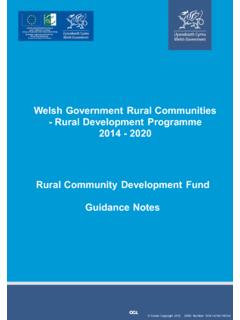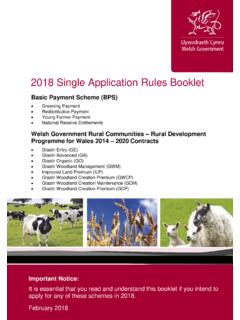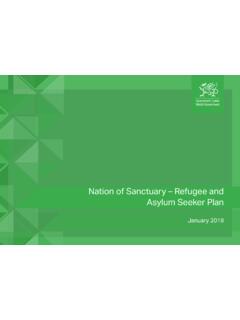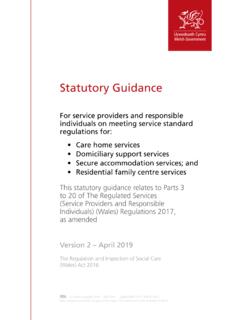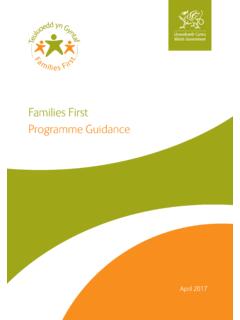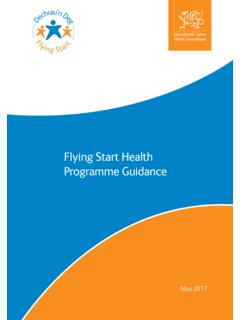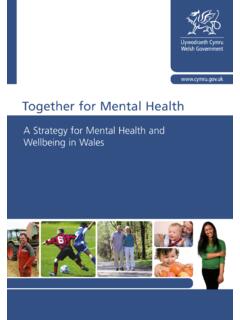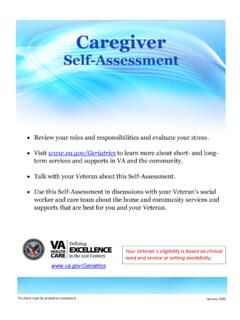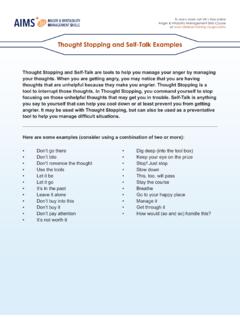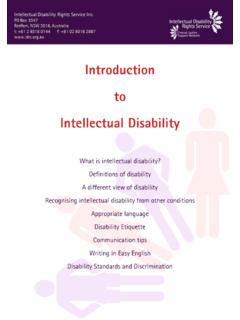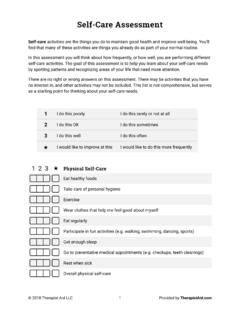Transcription of Talk to me 2 - GOV.WALES
1 Talkto meSuicide and self Harm Prevention Strategy for Wales 2015-20202 ISBN Digidol 978 1 4734 4038 8 Hawlfraint y Goron 2015 WG238893 CONTENTS MINISTERIAL FOREWORD 4 INTRODUCTION 6 SUICIDE AND self HARM DEFINITIONS 7 CURRENT DATA 8 STRATEGIC AIMS AND OBJECTIVES 15 IMPLEMENTATION MAKING IT HAPPEN NATIONALLY AND LOCALLY 17 PRIORITY PEOPLE AND PRIORITY CARE PROVIDERS 19 PRIORITY PLACES 23 4 MINISTERIAL FOREWORD Many people know of family, friends, neighbours or colleagues who have experienced the social and emotional consequences of suicide. Prevention of suicide and self harm remains a major public health and community challenge. Suicide is usually in response to a complex series of factors that are both personal and related to wider social and community influences. Consequently, no one organisation or government department can tackle the issue in isolation. Suicide and self harm prevention needs effective collaboration and joint working across central government departments, between local authorities and health boards, involving the third sector, service users and, of course, clinicians and professionals in a range of settings including schools, workplaces, hospitals and communities.
2 More can be achieved through true partnership than alone. It is for that reason Talk to Me 2 exemplifies a 3Cs approach, namely one that is truly cross-governmental, cross-sectoral and collaborative in design and delivery. This strategy and action plan addresses the period 2015 to 2020, builds on what has already been achieved and will sustain the momentum of recent years by focusing on a smaller number of achievable objectives and priority actions, all specific to suicide and self harm prevention. Talk to Me 2 acknowledges, but does not duplicate, other strategies and action plans, such as Together for Mental Health. The decision to focus on set priorities does not preclude other action being taken at either the national or the local level It is a defining characteristic of Talk to Me 2 that it identifies not just the risk and protective factors but also the many settings, services and groups of people that are to be taken into account: priority care providers have been identified to deliver action in priority places to the benefit of specific groups of priority people.
3 Stigma remains a cause for concern, and an area where improvement is needed. Just as with wider issues of mental health provision and support, stigma can isolate, stopping those in crisis from seeking help and preventing those left behind from accessing appropriate services and post-suicide bereavement support. I was pleased to launch Help is at Hand Cymru in 2013 to support those bereaved by suicide. Reducing stigma, improving awareness and understanding of suicidal behaviours amongst the public and those professionals and individuals who frequently come in to contact with people at risk of suicide and self harm, will encourage help-seeking behaviours and increase the chances of earlier, more timely interventions. 5 The action plan supports the delivery and steps needed to be taken at the national and local levels to implement this strategy. The varied social, cultural and geographical landscape of Wales means that local areas need to adapt and develop strategies according to local circumstances.
4 This national strategy provides the supportive and co-ordinated framework that makes such regional variation possible. I would like to thank Associate Professor Ann John for her leadership of the National Advisory Group, and its work to develop Talk to Me 2. I commend the strategy and action plan and anticipate further improvements in the months and years to come. Mark Drakeford AM Minister for Health and Social Services6 INTRODUCTION 1. This strategy document and associated action plan builds on Talk to Me, the 2009 national action plan to reduce suicide and self harm in Wales1. It sets out the strategic aims and objectives to prevent and reduce suicide and self harm in Wales over the period 2015-2020. It identifies priority care providers to deliver action in certain priority places to the benefit of key priority people, and confirms the national and local action required. 2. In 2012, Welsh Government launched Together for Mental Health, its 10 year strategy to improve mental health and wellbeing in Wales2.
5 This recognised that efforts to improve social, economic and environmental wellbeing in Wales are intertwined, and emphasised that improvements in mental health and wellbeing will only be achieved through concerted effort, the commitment of all Welsh Government departments and partner bodies. 3. An effective suicide and self harm prevention strategy would usually identify ways to establish, sustain and enhance mental health and wellbeing and community resilience to alter the life trajectories of people before they become suicidal. Together for Mental Health includes measures to develop individual resilience across the life course, and build population resilience and social connectedness within communities; it is for this reason such issues are not covered by Talk to Me 2. Similarly, Together for Mental Health and the Mental Health (Wales) Measure 2010 (the Measure)3 address the treatment and management of mental health disorders, and the rights, responsibilities and duties assigned to individuals and to services; both impact on the suicide and self harm agenda and should be read alongside this document.
6 The Social Services and Wellbeing Act and related Codes of Practice similarly stress the importance of emotional wellbeing in both adults and children, introduce key duties for local authorities, health boards and other bodies, and ensure greater consideration of issues such as carers' rights, safeguarding and innovative models of social service delivery. 4. Suicide is usually in response to a complex series of factors that are both personal and related to wider social and community influences. There is therefore no single reason why someone may try to take their own life. Suicide is best understood by looking at each individual, their life and circumstances. 5. It is however important to remember suicide and self harm are largely preventable, if risk factors at the individual, group or population level are effectively addressed. This requires a public health approach, broader than focussing on services for mental health service delivery, and which demands collective action by individuals, communities, services, organisations, government and society.
7 6. This means no single organisation or government department can take sole responsibility: suicide and self harm reduction must be cross-governmental, cross-sectoral and collaborative, with shared responsibility at all levels of the community, if it is to have a chance of success. The agenda therefore requires joint working across and between government at all levels, involving health boards, the third sector, and service users and professionals drawn from multiple 7 settings. Real partnership achieves more than individual action and the development of this strategy and action plan reflects that. 7. People who self harm or people in distress and at risk of suicide may come into contact with statutory or third sector services, in response to their actions or because they are actively asking for help. This strategy promotes the importance of a compassionate response to these individuals, encouraging future help seeking behaviour.
8 Those engaging in suicidal behaviours should be encouraged to be active partners in planning and managing their own care. SUICIDE AND self HARM: DEFINITIONS 8. Suicide is death resulting from an intentional self -inflicted act. 9. Suicidal behaviours range from suicidal thoughts, planning suicide, attempting suicide to completing suicide. 10. self harm is usually defined as intentional self -poisoning or self -injury. This covers a wide range of behaviours, including isolated and repeated events: self cutting, poisoning, scratching, burning, banging, hitting, hair pulling and interfering with wound healing. It challenges the individual, families and professionals alike. 11. Behaviours associated with substance misuse, risk taking or eating disorders are generally not considered self -harm because usually the harm is an unintentional side effect of the behaviour. However boundaries can be blurred, meanings differ in different contexts and there are often associations.
9 12. For the purpose of this strategy self harm is defined as intentional non-fatal self -poisoning or self -injury, irrespective of the degree of suicidal intent or nature / purpose of other types of motive. This definition is necessarily very general because the method, nature of motivation or degree of suicidal intent is complex and may change for any individual over time. It may be ambivalent, dissimulated or concealed and is often considered by the individual as a coping mechanism for the management of distress. Long-term outcome research in adults consistently highlights the association between self -harm and suicide 4 5. Those who repeat self harm are at significantly greater risk of completing suicide than those who have a single episode. It can be difficult to differentiate behaviours where there is an intent to die (cutting with suicidal intent) from those where there is a pattern of self harm with no suicidal intent (habitual self -cutting).
10 The latter is sometimes called non suicidal self injury (NSSI). 13. There is considerable debate on the usefulness of making this distinction for prevention. People who engage in suicidal and non-suicidal self -harm share a number of risk factors but there may also be distinct groups within these populations. Only a small fraction of those who engage in NSSI go on to make suicide attempts or die by suicide. self harm is an important public health problem in its own right, regardless of intent. It is one of the top five causes of hospital admissions in the UK. Many actions to prevent and reduce suicide will have benefits for those who self harm. For these reasons the strategy and action 8 plan in Wales includes self harm but recognises the complexities discussed above. CURRENT DATA 14. Suicide is rare but globally almost 800,000 die in this way each year 6. Worldwide it is the 15th leading cause of death accounting for approximately two in every 100 deaths.

